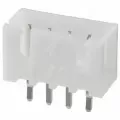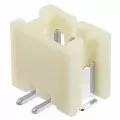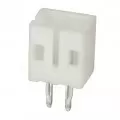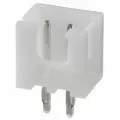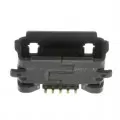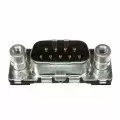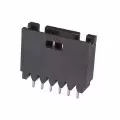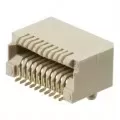OUTLINE:
A comprehensive analysis of the types of hdmi ports
 126
126As technology continues to advance and consumer needs become increasingly diverse, the hdmi port has undergone several iterations and upgrades, resulting in various types and models to meet the requirements of different scenarios. Nowadays, there are four main types of hdmi ports and each of them has its unique feature and advantage. See how these technological innovations have brought about a qualitative leap in our audio-visual experience!
Standard hdmi type A
The standard hdmi type A is currently the most common and widely used hdmi port type.
From its appearance, the standard hdmi type A connector has a flat trapezoidal shape. It has 19 pins, which perform different functions, including transmitting video signals, audio signals, clock signals, and control signals.
In terms of functionality, it can achieve high-definition video transmission as well as support various resolutions from standard definition to full HD (1080p) and ultra-high definition (4K, 8K). At the same time, it can transmit high-quality multi-channel audio signals to provide users with an immersive audio-visual experience. Whether watching movies, playing games, or conducting video conferences, the Standard HDMI Type A can ensure clear and vivid images, as well as realistic sound.
In terms of compatibility, the standard hdmi type A connector has strong universality, which can connect various devices, such as TVs, computer monitors, Blu-ray players, game consoles, and projectors. Therefore, this type of hdmi port is widely adopted by consumer-level electronic products and professional audio-visual equipment.
Moreover, with the continuous development of technology, the standard hdmi type A is also constantly upgraded. The newer versions support higher bandwidth, which can transmit higher resolution and higher frame rate video signals, as well as more advanced audio formats.
Mini hdmi type B
In terms of its appearance and size, the mini hdmi type B is relatively smaller than the standard hdmi type A which is discussed previously. But being portable is also the notable feature of mini hdmi type B, for which it is designed mainly to meet some specific needs of device connection that requires strict space, making it easy to use in miniaturized electronics.
For its pin number, the mini hdmi type B port uses a 29 pin design. The definition and function of pins have some similarities to standard hdmi interfaces, but there are also some differences. For example, the mini hdmi type B port also has pins for transmitting video and audio data to enable the transmission of high-definition audio and video signals. However, due to the increase in the number of pins, there may be some expansion in its data transmission capabilities and functions.
In terms of data transmission capability, the mini hdmi type B can support higher resolution and refresh rate than the common hdmi type A port. This interface can transmit high-definition video signals, including 2K, 4K or even higher resolution video content, and also has a good performance in terms of refresh rate, which can meet the needs of users for high-definition video playback and games and other applications.
Due to its compact size and strong capability, the mini hdmi type B is mainly used in some small electronic devices, such as some high-end digital cameras, camcorders, tablets, etc.
Micro hdmi type D
Micro hdmi type D is one type of high-definition multimedia port, and the following is a detailed introduction to it.
The micro hdmi type D interface is very compact and significantly smaller than the standard hdmi port. Its width is usually around 6 mm, and its thickness is also very thin, which makes it perfect for small electronic devices that have extremely tight space requirements. This compact design ensures the device's portability without sacrificing high-definition multimedia connectivity.
Furthermore, micro hdmi type D interface adopts a 19pin design. Although the number of pins is less than the standard hdmi type A interface, it can still achieve high-quality audio and video transmission.
For its data transmission capability, micro hdmi type D supports high-resolution video transmission, including 720p, 1080p and higher resolution video content, which allows it to deliver clear, delicate images even on small devices.
In terms of refresh rate, it also performs well, being able to meet users' needs for smooth video playback and gaming. For example, for some high-speed moving pictures, it can ensure that the image is clear and stable, without blur or stitch.
Many high-end smartphones and tablets are equipped with a micro hdmi type D interface so that users can output content from the device to a large-screen monitor or TV. In this way, users can watch videos, play games, display photos on a larger screen, improving the user experience.
Hdmi type E (for cars)
Hdmi type E is one type of hdmi ports specifically designed for automotive applications
to meet the complex environment inside the car. As cars may face many challenges during driving, such as vibration, temperature changes, electromagnetic interference etc., so this interface needs to have higher stability and reliability.
Moreover, the hdmi type E is generally designed to be robust and able to withstand the vibration and shock of the car during driving.
For size considerations, the width and thickness of hdmi type E is usually optimized based on the installation space inside the car. It is necessary not only to ensure the connection stability of the interface, but also to minimize the space occupied, so that it can be easily installed and used in the center console and seat back of the car.
In order to cope with electromagnetic interference in the car, the hdmi type E uses special shielding technology to ensure the stability and reliability of signal transmission.
Like other hdmi ports, type E is also capable of supporting high-resolution video transmission.
Last but not least, hdmi type E can be connected to a variety of devices that support hdmi output, such as smartphones, tablets, laptops, game consoles, etc. By connecting these devices, passengers can watch movies, play music, play games and more in the car.
To ensure compatibility with different devices, hdmi type E usually follows the specifications of the hdmi standard and supports multiple hdmi protocols. This allows it to seamlessly connect with different brands and models of devices without worrying about compatibility issues.
Functions and characteristics of different types of hdmi ports
There are four main types of hdmi (High-Definition Multimedia Interface) ports, and the functions and characteristics of different types are gathered in a table as follows for your further consideration.
|
Type |
Function |
Characteristic |
|---|---|---|
|
HDMI Type A |
the most common type of HDMI port, mainly used to connect HD TVS, monitors, projectors and other devices.
capable of transmitting HD video and multi-channel audio signals in a variety of resolutions including 720p, 1080p, 4K and beyond.
two-way communication can be achieved, allowing the transmission of Control signals between devices, such as one-click control of devices through the HDMI-CEC (Consumer Electronics Control) function.
|
relatively large size with 19 pins.
widely used in various consumer electronic devices, having strong compatibility.
the transmission speed is fast, which can meet the high bandwidth video and audio transmission requirements.
|
|
HDMI Type B (Mini HDMI) |
suitable for miniaturized electronic devices, such as tablets, digital cameras, camcorders, etc.
easy to connect on devices with limited space, but also connect to devices with Type A ports using conversion cables.
|
smaller size, more compact than Type A ports.
often used in portable devices, easy to carry and use.
|
|
HDMI Type D (Micro HDMI) |
used for ultra-small electronic devices, such as smartphones, action cameras, etc.
transmit high-definition video and audio signals with supported resolutions and frame rates similar to other types of HDMI ports.
convenient HD multimedia connectivity on extremely small devices.
|
very small size, is one of the smallest HDMI ports.
with the popularity of devices such as smartphones, Micro HDMI ports are becoming more widely used.
a transfer cable is also required to connect to a device with a Type A port.
|
|
HDMI Type E (for Automotive) |
specifically designed for automotive applications to connect devices such as in-vehicle entertainment systems, navigation systems, etc.
support car specific functions, such as reversing image display, vehicle multimedia control, etc.
|
highly integrated with automotive electronic systems and more convenient to install and use.
high reliability and stability, ensuring that there will be no signal interruption and other problems during the driving process.
|
Common problems and solutions of different types of hdmi ports
1. No signal or signal instability
Cause: The connection is not secure, OR the cable is damaged, thus failing the normal operation of the device, or the driver is faulty.
Solution: Make sure the plug is firmly inserted, replace the cable with good quality, and then confirm compatibility between devices and update the driver.
2.Abnormal image display
Cause: resolution mismatch, color problems, signal interference, etc.
Solution: Adjust the resolution and color Settings, keep away from interference sources, and replace the cable if necessary.
3. Audio problems
Cause: The configuration is incorrect, the driver is faulty, or the cable audio transmission is faulty.
Solution: Check the audio Settings, update the audio driver, test the replacement cable.
4. Easy to damage the interface
Cause: Improper insertion and removal, small interface size and easy to damage.
Solution: Insert and remove carefully, avoid excessive force, and repair in time after damage.
Final Verdict
In short, different types of hdmi ports all play important roles in meeting the connectivity needs of various devices. Whether in home entertainment, professional or automotive applications, hdmi ports bring us a rich audio-visual experience with their high-definition video and audio transmission capabilities.

Disclaimer: The views and opinions expressed by individual authors or forum participants on this website do not represent the views and opinions of Chipsmall, nor do they represent Chipsmall's official policy.

share this blog to:



